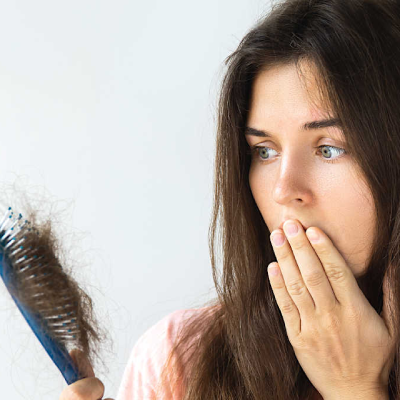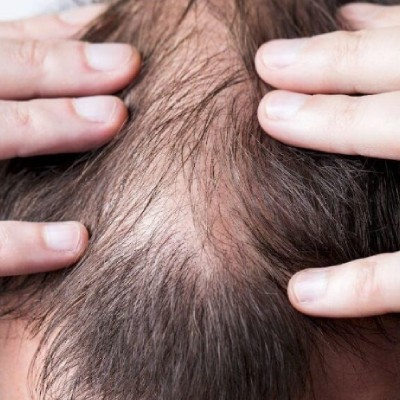Various Stages of Baldness & How to Treat It

31 July 2018

Hair Experts @ AHS

Male Pattern Baldness is the most common cause of hair loss in men. Around one fourth of the population start to see the symptoms of male pattern baldness as early as twenties.
Baldness is a condition that has plagued innumerable people irrespective of their gender and age. It can be associated with many things. One of them can be hereditary. If you inherit the hair loss gene, you can expect hair loss at some time in your life.
Baldness can be due to certain deficiencies in our bodies as well. Deficiency of Zinc, Vitamin D, and Iron are associated with hair loss as well. Causes of baldness are subjective. In order to make a treatment fit for your condition, it is important to isolate the reason for your hair loss.
This blog will tell you about different types of hair loss and how you can treat it.
What Are the Symptoms of Baldness?
First, one needs to understand that baldness and hair loss are common worldwide. While it is not desirable, in most cases, it is not caused by any underlying disease. Your body gives you enough signals to help you identify it.
Receding Hairline
One of the most prominent symptoms of baldness is a receding hairline. It should be noted that men suffer from it more and women generally face hair thinning. A slight recession of the hairline from the temple region is expected as we age but some men can experience it as early as they finish puberty.
The hairline will keep moving back unless treated. It could be because of family history or a change in the hormones. A higher level of testosterone and changes like menopause can be associated with this change.
Bald Spots
Another prominent symptom is the occurrence of bald spots. This condition is also known as Alopecia areata. You may see a patch of baldness on your scalp while the rest of the mane will appear healthy.
This is an autoimmune disease that is often associated with a compromised immune system of hair follicles. Spot baldness is also linked with psychological stress.
There is no cure for alopecia areata but preventative measures can be taken. Cortisone injections are applied to the affected area that can result in hair regrowth. It is better to protect the scalp from the sun as the rays can worsen the condition.
Other Symptoms
Other common symptoms of baldness are excessive hair fall, brittleness, slow hair growth and flaky scalp.
Various Stages of Baldness

Baldness does not happen overnight. It occurs in stages and there is a scientific scale that is used for measuring it. In the 1950s, James Hamilton devised a scale to measure baldness, especially in males. This scale was improved in the 1970s by Dr. O’Tar Norwood.
According to the Norwood scale, there are seven stages of baldness. The scale is progressive in terms of hair loss. The stages are as follows:
Stage 1
This stage is known as the control stage. Baldness is hardly noticeable as the person will still see a full head of hair. A person might lose hair rapidly and the hairline remains intact or shows very little change.
Stage 2
The person can see the hairline receding from the temple region. The change is only slight and hair loss is still not prominent.
Stage 3
Hair loss is quite evident at this stage and easily noticeable. The hairline recedes further, creating an M-shaped curve at the temple. This is the class A version of the third stage or stage 3A. At this point, you will not see a defined dip in the hairline.
Stage 3 Vertex
There is a less drastic change in the hairline at stage 3 vertex as compared to Stage 3. The hairline might not be affected significantly but hair loss on the crown area is evident. Some men also begin to see bald spots.
Stage 4
Hair loss is prominent at this stage. The hairline moves back further and appears U-shaped. The crown region’s bald spot enlarges and appears to be closer to the hairline. However, you will still see some hair between the two.
If there is no bald spot at the back of your head but the hairline is forming a U-shaped figure, then, you are at stage 4A.
Stage 5
The strip of hair between the bald spot of the crown and the hairline is still there but it is scantier than the previous stage. The hairline continues to move towards the back of the head and the hair fall continues. This stage is a severe form of stage 4. Stage 5A sees the hairline pushing backwards.
Stage 6
There is no patch of hair between the receding hairline and the bald spot on the crown region. There is no visible hair on the temple region and top of the head. The only trace of hair can be seen around the sides of the head but there is none anywhere else. At this stage, a person is almost bald.
Stage 7
On the stages of male pattern baldness, this is the last one. The hair from the side of the head is also gone. At most, there is a thin circle of hair outside the head region. Any hair growth is weak and not enough to sustain itself.
What Are the Main Causes of Baldness?
There are various causes of baldness. It varies with age, gender, environmental conditions, medical history and genetics. Some of the most common causes of baldness are:
Family History
According to the Mayo Clinic, this is the most common cause of baldness. As you age you start losing hair. The medical term for this condition is androgenetic alopecia. It is loosely called female pattern baldness and male pattern baldness.
The change is gradual but noticeable. Men will have a receding hairline and hair loss while women will face hair thinning, especially along the crown region.
Hormonal Changes
While hormonal changes post-puberty can cause baldness in men, there are other hormonal changes as well that are associated with hair loss.
Hormonal changes during childbirth, menopause, and pregnancy can cause temporary or permanent hair loss. Thyroid problems and cortisol released due to stress can also lead to hair loss.
Medication
Certain drugs that are used to treat medical problems like arthritis, gout, high blood pressure, depression and cancer can cause permanent or temporary hair loss and baldness.
Scalp Infection and Skin Disorder
Scalp infection can lead to patchy baldness. One example is the baldness caused by the scalp ringworm. Some skin disorders can also lead to hair loss and eventually baldness. Lupus and psoriasis make skin extremely dry. This can result in the shedding of the upper layer of the scalp skin leading to hair loss.
Hair Care
How you treat your hair regularly can also decide whether you will lose your hair or not. Tying hair in a tight ponytail for long hours and cornrows can cause stress to the hair follicles. Using hard water for hair wash can also result in loss of hair. Using hot hair tools can also cause permanent damage to the hair shafts.
Hair Treatments
One of the most common mistakes that people do is to go for oil treatments without consulting a dermatologist or checking the type of scalp. If you have an oily scalp, then oil treatments will make the situation worse. Other treatments like hair coloring, straightening and dyeing can also cause baldness.
Natural Triggers
Many people experience increased hair loss after a trauma or when they are stressed. While the changes brought by these natural triggers are often short-lived, they can become permanent if not taken care of on time.
What Are the Best Treatments for Baldness?
Treating hair loss or baldness depends on the cause of baldness. In some cases, preventative measures like using a good quality wooden comb, styling hair loosely, following a healthy lifestyle, and changing the medication are enough to change the course of baldness.
In other cases, preventative measures may be futile. When the level of baldness is on an upper scale, your doctor may prescribe you one or more of the following baldness treatments:
Medication

Some over-the-counter medicines and topical ointments have shown results in stopping baldness. Minoxidil, a drug that was developed for high blood pressure, showed the growth of unwanted hair as a side effect.
This gave pharmaceutical companies the idea to include it in hair loss treatments. You can easily find minoxidil rogaine based creams and serums in the market. Finasteride is another drug that can help with baldness. If you are still at very initial stages of hair thinning, you may consider it; but with a pinch of salt. These drugs are known only to work on a certain percentage of people.
Surgery

This includes hair transplant. Hair follicles from the back of your head are extracted and planted in the front. As this hair is DHT resistant, it can grow eventually.
Non-Surgical Hair Loss Solutions

Advancements in medicine have made it possible to slow or stop the progression of hair loss, but successful hair loss treatment is largely dependent on early intervention. It is important to get professional help as soon as you notice baldness.
It is easier to slow down the hair loss than to stimulate hair growth. The hair follicles that stopped producing hair become dormant after about two years and cannot be revived. However, once significant hair loss has occurred, non-surgical hair loss solutions may be the best option.
Hair restoration technology has magnificently advanced in the past few years. The revolutionary non-surgical hair replacement procedures are now available to replace the lost hair with natural-looking results.
Conclusion
Baldness is not a new phenomenon and has affected many. If you pay attention to the early symptoms of baldness and consult an expert, it can be managed in a better way.
At Advanced Hair Studio, we customize treatments for baldness and hair loss after a thorough inspection of your hair and scalp. Our hair experts ensure that you get the best treatment for saving your precious hair.
FAQs on Baldness
How Can I Grow Hair on My Bald Spot?
You can use countertop hair treatment that has minoxidil and finasteride. However, it is better to take professional advice from our hair experts on how to get a head full of hair.
Does Balding Slow Down After 30?
There is no scientific proof backing this theory. Age is only one of the factors that affects hair loss. We need to consider other variables too like genetics, environment and medical history.
How Can I Stop My Hair from Falling Out and Control Balding?
First, follow a healthy diet and give your hair the nutrients it deserves. Physical activities increase blood circulation that can curb balding. If nothing seems to work, consult an expert.
How Can I Check My Baldness Level?
You can check your level with a personalised hair check with a hair expert. For this you need to visit a hair specialist.
Stay Updated
Subscribe to our email newsletter for helpful tips and valuable resourses
Be an influencer
Join forces with Advanced Hair Studio! Explore exciting collaboration opportunities tailored for influencers. Let's redefine haircare together.
Connect now












